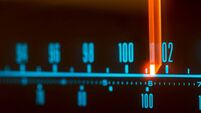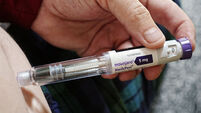A common dolphin, but rarely seen
The Irish Sea, on the other hand, offers a mere 60-mile vista. Its tainted waters seem murky and the nuclear waste discharges from Sellafield do nothing to improve its image.
This may be the world’s most radioactive water body, but emissions are so low that the addicted fish-eater has nothing to fear. Nor is the Irish Sea’s cesspool profile accurate.
Some of the world’s most important seabird colonies are on its shores. Seals and dolphins love what seems to them to be a large Atlantic bay, although it’s nowhere more than a hundred metres deep.
Last week, the Mooney Goes Wild team travelled on the Isle of Inishmore ferry from Rosslare to Pembroke. According to Captain Colm Clear, this 34,000-tonne ship is the third largest car ferry in Europe. It’s a beautiful, well-appointed vessel, although slightly misnamed; since ‘Inish’ means ‘island’, the ‘Isle of’ part of the name is superfluous, but then Yeats himself made the same mistake with his ‘Lake Isle of Inishfree’.
Zoologist David Wall, of the Irish Whale and Dolphin Group, sails regularly on Irish Ferries’ ships, counting whales and dolphins. He travels in style, beside the captain on the bridge, scanning the sea with his binoculars and recording every sighting. The Rosslare to Pembroke route, according to David, is good for whale watching. The rising tide brings a massive flood northwards from the rich Celtic Sea, with an equally powerful discharge on the ebb. These ferocious currents attract plankton fish and other sea creatures, food for whales and dolphins.
On the crossing last week, the sea was calm and the visibility excellent. Things were quiet, initially. Occasionally, a porpoise or two would break the water surface. These little ‘sea-pigs’ were once thought to be dolphins, but now they are placed in a family of their own. There are only six species world-wide, the harbour porpoise being the only one found in our waters. Unlike dolphins, porpoises rarely leap out of the water, preferring to roll slowly, with only their black backs and dorsal fins visible.
Then, the first common dolphins appeared. Colourful, little characters with yellow breasts and an egg-timer pattern on the flanks, these were known to the ancient Greeks. Their biological name, Delphinus delphis, makes them the flagship species of the dolphin tribe. Found throughout the warmer oceans, there are probably more common dolphins in the world than any other cetacean. Although they are the most abundant Irish dolphin, they are not the most often seen. Common dolphins prefer to stay well out from the coast, unlike their bottle-nosed cousins, which frequent bays and estuaries.
Then, off the Tuskar Rock, another cetacean appeared. In 1911, a naturalist named Risso drew the attention of the great French scientist, Baron Cuvier, to a previously unknown dolphin. Cuvier prepared a scientific description of the animal, which he named after the man who reported it. Risso’s dolphin likes warmer waters and the increase in its numbers off Ireland may be an effect of climate change. It’s a large dolphin with a prominent dorsal fin, shaped like a sickle.
Grey on top and lighter underneath, it has a horse-like face. It eats squid octopus and cuttlefish, hunting near the coast in summer and moving to deeper waters in winter. The scars on the bodies of older males are a legacy of fights over females. A successful Risso bull will have a harem of concubines, which he defends against all challengers.
The world’s most famous Risso was Pelorus Jack, a dolphin which raced boats and fraternised with people in New Zealand’s Cook Strait, from 1888 until his death in 1912. Perhaps our Fungi is a reincarnation of Jack, in a dolphin equivalent of the Hindu doctrine of Karma. Fungi, of course, is not a Risso, but a bottle-nose. Oddly, no bottle-noses were seen during our crossing to Wales, but they do frequent the Irish Sea.
Dolphins and porpoises have teeth. Of the world’s 76 whale species, 66 are toothed. The remaining ten use a sieve, rather than teeth, to catch their prey. Two of the largest animals ever to have lived, the blue whale and the fin whale, belong to this baleen group. Although a fin whale became stranded on the coast in County Down, the only baleen whale seen regularly in the Irish Sea is the minke, the smallest of the tribe. The name is a corruption of Meincke, a notorious Norwegian whaler who killed whales normally regarded as too small to exploit.
But David not only identifies each species seen, he must estimate the number of animals in each pod and determine how many individuals are present, a most difficult task. Dolphins spend most of their time under the water, only surfacing to breathe. The number of animals visible at a particular moment is no indication of the size of a pod. It takes knowledge and experience to come up with an accurate figure.
Findings by David, and other observers, indicate that the Irish Sea has a thriving population of porpoises and dolphins. So, on your next ferry crossing, if the weather is reasonably calm, stay out on deck for an encounter with these fascinating animals. It could be the highlight of your trip.














